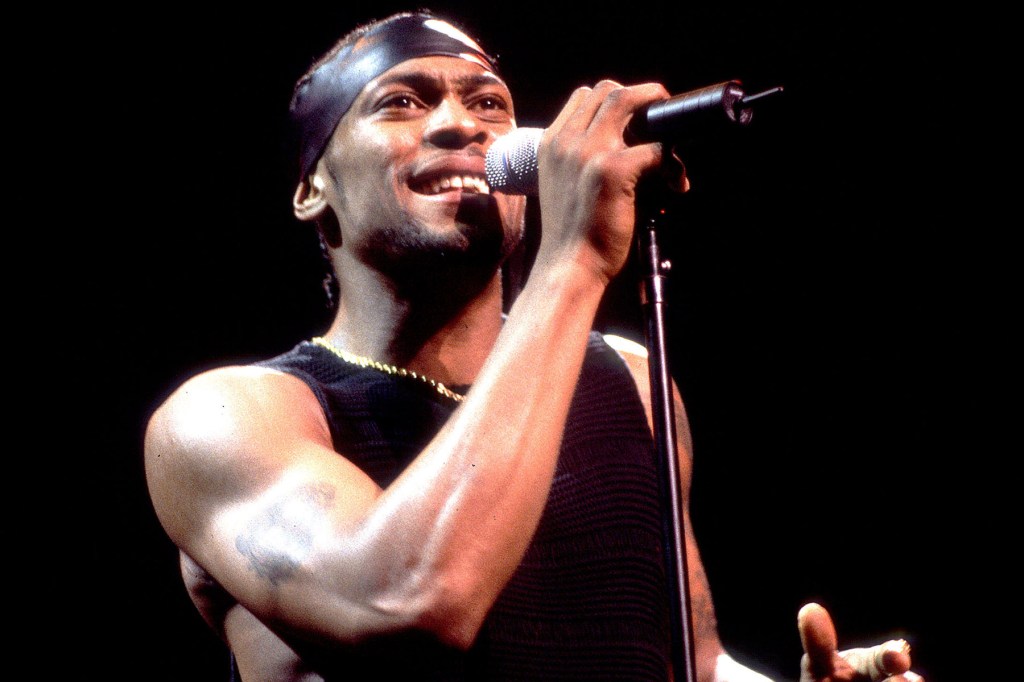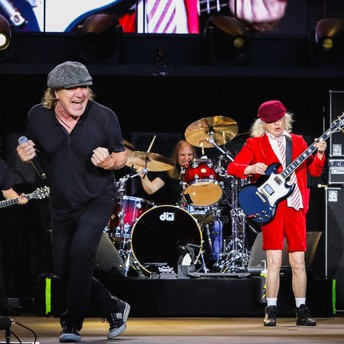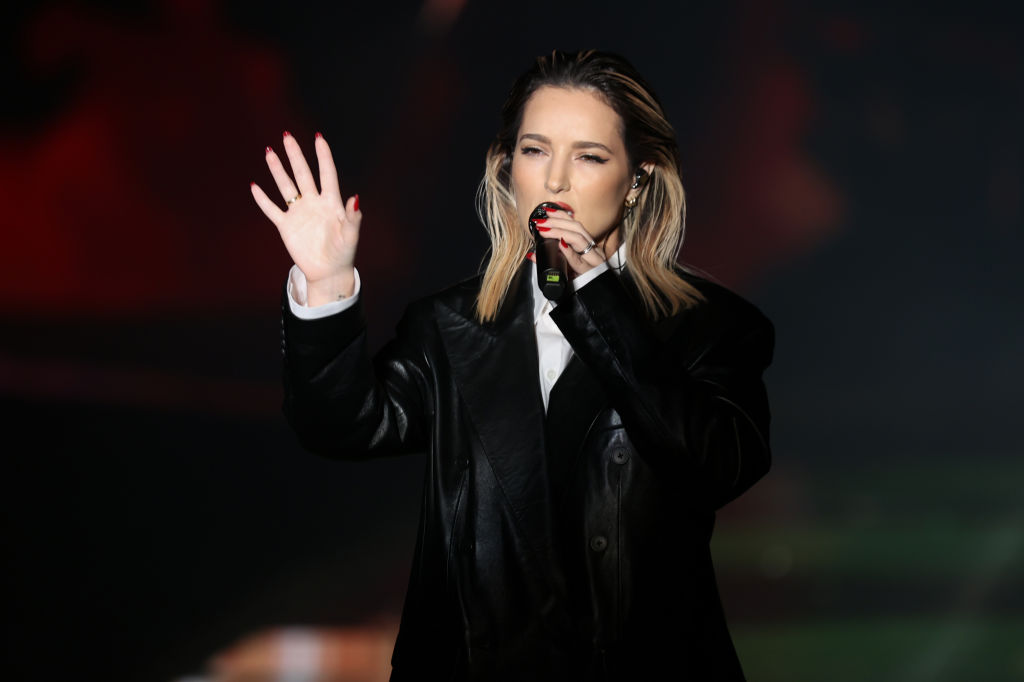Music
Page: 58
Trending on Billboard
AC/DC came to rock the Melbourne Cricket Ground on Wednesday night, Nov. 12 and the city felt it.
The opening date of AC/DC’s Power Up tour of Australia made waves that were detected by earthquake monitoring equipment, and could be felt, and heard, deep into this former Olympic City.
According to Adam Pascale, chief scientist at the Seismology Research Centre, the concert registered in the 2-5 hertz range at their office in Richmond, some 2 miles from the concert at the towering MCG.
Explore
See latest videos, charts and news
That’s enough force for people to feel the ground move.
“The sound waves that people were experiencing nearby and feeling something through their bodies, that’s the equivalent to what our seismographs feel,” Pascale told the Australian Broadcasting Corporation. A resident some 6 miles away told the ABC they could hear the concert.
“We’re picking up the ground motion, we’re not picking up the sound from the air,” Pascale added.
“So, you’ve got speakers on the ground pumping out vibrations and that gets transmitted through the ground, but also the crowd jumping up and down is feeding energy into the ground.”
Although AC/DC came to rock, the largest signals received by the Seismology Research Centre were generated by Taylor Swift’s record-busting three-night stand at the MCG in 2024, Pascale remarked.
Stadium rock can move us, literally. Oasis’s now-completed tour of Live ’25 tour of Australia (via Live Nation) generated a “clear uptick in seismic signal” when fans “started pounding the ground” at Marvel Stadium during a show earlier in the month, the center confirmed earlier.
AC/DC doesn’t do things by halves. These latest round of shows require 300 tons of steel to build the production, with 28 tons of PA and speakers pumping out the sound. A crew of 155 are working each show, which consumes 500kw of power every night.
With Angus Young on lead guitar, vocalist Brian Johnson, rhythm guitarist Stevie Young, drummer Matt Laug and bass player Chris Chaney, the Rock Hall-inducted legends ripped out the classics at the MCG, including “Back In Black,” “Thunderstruck,” “Hells Bells,” “Riff Raff” and much more.
AC/DC last toured Australia and New Zealand in 2015, the domestic leg of their Rock or Bust world tour. On that visit, Young and Co. shifted more than 520,000 tickets across 11 coast-to-coast dates, including shows in Auckland and Wellington.
Next up, the second of two shows this Sunday (Nov. 16) at the MCG, followed by dates in Sydney, Adelaide, Perth and Brisbane.
TEG Van Egmond, a division of TEG, is producing AC/DC’s nine-date national tour, with special guests Amyl & The Sniffers.
AC/DC 2025 “Power Up” Australia Tour Dates:
Nov. 12 — Melbourne Cricket Ground (completed)
Nov. 16 — Melbourne Cricket Ground
Nov. 21 — Accor Stadium, Sydney
Nov. 25 — Accor Stadium, Sydney
Nov. 30 – Adelaide bp Adelaide Grand Final
Dec. 4 — Optus Stadium, Perth
Dec. 8 — Optus Stadium, Perth
Dec. 14 – Suncorp Stadium, Brisbane
Dec. 18 – Suncorp Stadium, Brisbane
Trending on Billboard
Christopher Cross’ “Sailing” isn’t coming in to dock anytime soon.
The American singer, songwriter and guitar talent released his “yacht rock” masterpiece back in 1979, a classic that sailed all the way to No. 1 on the Billboard Hot 100.
“Sailing” was one of four top 20 hits that appeared on Cross’ self-titled album, which, in 1981 would make history at the Grammy Awards, by sweeping five categories, including the Big Four — album, record and song of the year. Yes, it was unexpected. A shock, even. The only other artists to scoop the Big Four was Billie Eilish, doing so four decades later, in 2020.
Explore
See latest videos, charts and news
If “Sailing” was a guilty pleasure in the 1990s, today it’s simply a pleasure. The softly-spoken artist stopped by Jimmy Kimmel Live earlier this week to take us all “Sailing,” the video of which can be seen below.
Cross, a formidable guitarist who was blessed with the voice of an angel, appears to have made a full recovery from his grueling health battle five years ago, during which he contracted Guillaine-Barre Syndrome (GBS) after having COVID-19.
At one stage, he was paralyzed from the waist down. “It really was touch and go, and tough,” he CBS Sunday Morning at the time.
Cross’s late-night spot came ahead of the release this Friday, Nov. 14 of All Right: The Worldwide Singles 1980–1988, the first career-spanning collection of his biggest hits, including “Arthur’s Theme (Best That You Can Do),” from the film Arthur, which also led the Billboard Hot 100 and won an Academy Award for best original song. The set is released through Omnivore Recordings, the label that issued an “expanded edition” of Christopher Cross in June 2025.
Now aged 74, Cross will play many of those hits when he embarks on a South American tour this December, including shows with fellow ‘80s heavyweights Toto. Live shows across the U.K. and Europe follow from May 2026.
Trending on Billboard
Ninajirachi’s hot streak shows no signs of cooling off.
The DJ, songwriter and electronic music artist adds to her collection the triple j album of the year and Australian music video of the year, two of five awards handed out Wednesday, Nov. 12 by the state-funded youth network.
The 26-year-old musician nabbed the top award, album of the year, for her debut full-length effort I Love My Computer (via NLV Records), which beat out a ten-strong shortlist of LPs by the likes of Tame Impala, Mallrat, Spacey Jane, OneFour and others.
Explore
See latest videos, charts and news
Ninajirachi also collected the top music video honor, for “F*** My Computer,” directed by Ball Bass John.
It’s all happening for Ninajirachi, known to her friends and family as Nina Wilson. Just last week, she collected the coveted Australian Music Prize (AMP), and its A$50,000 ($32,800) winner’s check, for her studio collection. And there’s a strong chance to add more when the 2025 ARIA Awards roll on next Wednesday, Nov. 19, where she’s competing for a leading eight pointy trophies.
After wrapping up her Australian tour in the early stages of 2026, the rising star will embark on her biggest north American jaunt yet, including a first-ever slot at Coachella.
“I really just had a good time making an album. I hope I can keep making albums that feels as good as this one did,” she told the Australian Broadcasting Corporation following her AMP win. “I’ve been making music for a long time and I could have never predicted what this year would look like. So it’s hard to say (what the future holds). I just hope it keeps feeling as fun as it has been recently.”
Now in its 21st year, the J Awards celebrate the cream of Australia’s crop of recorded musicians, live performers, emerging talent and more, and coincide with triple j’s Ausmusic Month. This year, 26 local artists were nominated for the J Awards.
Other winners announced by the ABC, parent of triple j, included Folk Bitch Trio (Unearthed artist of the year), Grammy and Brit Award-nominated punk rock act Amyl and The Sniffers (Double J Australian artist of the year) and SPEED (Australian live act of the year).
See the full list of 2025 J Awards nominees and winners below.
triple j Album of the Year
• Ninajirachi – I Love My Computer (WINNER)
• Baker Boy – DJANDJAY
• Folk Bitch Trio – Now Would Be A Good Time
• grentperez – Backflips in a Restaurant
• Mallrat – Light hit my face like a straight right
• ONEFOUR – Look At Me Now
• Spacey Jane – If That Makes Sense
• Tame Impala – Deadbeat
• The Rions – Everything Every Single Day
• Thornhill – BODIES
Unearthed Artist of the Year
• Folk Bitch Trio (WINNER)
• Don West
• Darcie Haven
• Sam Alfred
• PLAYLUNCH
Double J Australian Artist of the Year
• Amyl and The Sniffers (WINNER)
• Emily Wurramara
• Gordi
• Meg Washington
• Paul Kelly
rage and triple j Australian Music Video of the Year
• Ninajirachi – “F*** My Computer” (dir. Ball Bass John) (WINNER)
• Drifting Clouds – “Bawuypawuy” (dir. Matt Sav)
• Ecca Vandal – “CRUISING TO SELF SOOTHE” (dirs. Ecca Vandal and Richie Buxton)
• PLAYLUNCH – “Keith” (dir. Riley Nimbs)
• RONA. – “Show Me” (dir. Tyson Perkins)
Australian Live Act of the Year
• SPEED (WINNER)
• Amyl and The Sniffers
• Ball Park Music
• Miss Kaninna
• xmunashe
Trending on Billboard
Radiohead’s second live album, Hail to the Thief: Live Recordings 2003-2009, makes a top 10 debut across four Billboard album charts (dated Nov. 15), including a No. 8 bow on Top Album Sales, marking the band’s ninth top 10. The set also enters the top 10 on Indie Store Album Sales (No. 4), Vinyl Albums (No. 5) and Top Current Album Sales (No. 8).
On the overall Billboard 200 chart, the set squeaks in at No. 200, landing the group its 17th chart entry. The set also bows at No. 30 on Independent Albums and at No. 48 on Top Rock & Alternative Albums.
In the tracking week ending Nov. 6 in the United States, the album earned a little over 8,000 equivalent album units, of which essentially all were in traditional album sales (purchases of digital and physical copies of the album).
Billboard’s Top Album Sales chart ranks the top-selling albums of the week based only on traditional album sales. The chart’s history dates back to May 25, 1991, the first week Billboard began tabulating charts with electronically monitored piece count information from SoundScan, now Luminate. Pure album sales were the sole measurement utilized by the Billboard 200 albums chart through the list dated Dec. 6, 2014, after which that chart switched to a methodology that blends album sales with track equivalent album (TEA) units and streaming equivalent album (SEA) units.
Radiohead’s new live album is one of six debuts or re-entries among the top 10 on the latest Top Album Sales chart, where Florence + the Machine’s Everybody Scream debuts atop the list. Tyler, The Creator’s chart-topping CHROMAKOPIA reenters at No. 2 after its one-year anniversary reissue on CD, vinyl and in two deluxe boxed sets (each containing branded merch and a copy of the CD). Grateful Dead’s latest archival live set Dave’s Picks, Vol. 56: Rainbow Theatre, London, England, 3/20/81 & 3/21/81 enters at No. 3, while Taylor Swift’s former No. 1 The Life of a Showgirl slips 3-4. The KPop Demon Hunters soundtrack rises a spot to No. 5, while Hamilton: 10 Shots (Highlights From the Original Broadway Cast Recording) bows at No. 6. Stray Kids’ chart-topping KARMA climbs 9-7, Bob Dylan’s from-the-vaults compilation Through the Open Window: The Bootleg Series, Vol. 18, 1956-1963 debuts at No. 9 and Vince Guaraldi Trio’s A Charlie Brown Christmas soundtrack returns to the top 10, rising 14-10.
Over the past few years, Busta Rhymes has experienced a resurgence of sorts as the man released some pretty impressive albums and found himself being featured on other artists’ records like it was the late 90s all over again, and now the man is lending his talents to an up-and-coming Latina artist that will no doubt be making much noise going forward.
Linking up with Minelli for the black-and-white visuals to “Azucar,” Bussa Buss and Minelli kick it on a private estate where they use the fancy backdrop to conduct a photoshoot while they display their musical talents and show they can pull off quite a few poses in luxurious leather attire.
Back in the South, Lil Flip is still balling something serious (pause?) and for his clip to “Slingshot,” the rap veteran pulls out some supped up slingshot automobiles to roll around town before pulling over and throwing a block party of sorts where he gets turnt up with his peoples.
Check out the rest of today’s drops, including work from Do Or Die, YFN Lucci, and more.
MINELLI & BUSTA RHYMES – “AZUCAR”
LIL’ FLIP – “SLINGSHOT”
TIANA MAJOR9 FT. YEBBA – “ALWAYS”
DO OR DIE – “FANTASY”
YFN LUCCI – “GHOST.”
A-F-R-O & STU BANGAS FT. WORDSMITH – “MASTERMIND”
BISHOP NEHRU – “KEEP IT A BEAN”
SPICE 1 FT. RICO 2 SMOOVE – “GOONIN”
—
Photo: Getty
Trending on Billboard
Ultra Music Festival today (Nov. 12) added more than 70 news acts for the 2025 edition with the announcement of its phase two lineup.
Joining the bill are Martin Garrix and Alesso, who will play b2b in a headlining slot, the first ever headlining performance from Argy b2b Mind Against and Ray Volpe b2b Sullivan King. DJ Snake will perform the U.S. debut of his Outlaw alias in a b2b with TYRM and Joris Voorn and Kololova will also perform b2b for the first time in the States.
Additionally, Ultra will host stage takeovers from legendary Ibiza club Amnesia, The Martinez Brothers’ Cuttin’ Headz, Armin van Buuren’s A State of Trance, Steve Aoki’s 30 years of Dim Mak, Coone’s Dirty Workz, Sara Landry’s Hekate and Germany’s Live From Earth collective.
These additions expands the previously announced phase one lineup that includes Afrojack, Amelie Lens b2b Sara Landry, Armin van Buuren, DJ Snake, Eric Prydz, Illenium, John Summit, Hardwell, Major Lazer, Steve Aoki, Sebastian Ingrosso b2b Steve Angello, Miss Monique, Excision, ISOxo, Boys Noize, OF the Trees, Madeon and many more. See the complete lineup below.
Ultra Music Festival 2026 happens March 27-29 at its longtime home at Miami’s Bayfront Park.
The festival annually closed out Miami Music Week a week-long run of parties, showcases, meetings, mixers and more that draws many in the global electronic music industry to the city. Winter Music Conference returned to Miami Music Week in 2025 after a hiatus, with organizers announcing earlier this week that it will be back in 2026 and happen in a new location at the Kimpton EPIC Hotel in Downtown Miami from March 24–26.
2026 will mark the 36th year of the conference. The next edition is set to feature a programming track tailored for dance industry professionals and a second track for DJs, producers and content creators.
Ultra Music Festival 2025
Alive Coverage

Trending on Billboard
D’Angelo’s son, Swayvo Twain (born Michael Eugene Archer Jr.), spoke out for the first time since his music icon father’s funeral in a heartfelt post to Instagram on Wednesday (Nov. 12), which featured parts of his emotional eulogy at the neo-soul legend’s memorial service last month.
“My dad, he came down to Atlanta. He spent three weeks with me. Anything we ever missed, any questions I ever had, anything I wanted to ask him about — anything — we just had every conversation,” Twain recalled. “Every laugh and every moment, man. It really just cleared my spirit, man. That’s the time I needed him the most ever. He stood right there.”
Twain explained how he gained a ton of clarity following his father’s funeral. “My mom [Angie Stone] passed and it left me with a lot of questions,” the 28-year-old added. “After [D’Angelo’s] funeral, I gained a lot of answers to things.”
Twain, a rapper and singer in his own right, is the eldest child of D’Angelo, who has two younger siblings: 26-year-old Imani and 15-year-old Morocco.
D’Angelo died at 51 years old following a battle with cancer on Oct. 14. “The shining star of our family has dimmed his light for us in this life,” his family said in a statement to Billboard. “After a prolonged and courageous battle with cancer, we are heartbroken to announce that Michael D’Angelo Archer, known to his fans around the world as D’Angelo, has been called home, departing this life today, Oct. 14, 2025.”
“We are saddened that he can only leave dear memories with his family, but we are eternally grateful for the legacy of extraordinarily moving music he leaves behind,” the statement continued. “We ask that you respect our privacy during this difficult time but invite you all join us in mourning his passing while also celebrating the gift of song that he has left for the world.”
There was an outpouring of tributes from the music community, including heartfelt messages from Doja Cat, Tyler, the Creator, Jill Scott, The Alchemist and DJ Premier.
Find Swayvo Twain’s post about his late father below.
Trending on Billboard
The life and career of 13-time Grammy winner Kenneth “Babyface” Edmonds will take center stage in a documentary that’s now in production and backed by HarbourView Equity Partners. Helming the documentary are Emmy-nominated director Chris Moukarbel (Gaga: Five Foot Two, Cypher) and Kenya Barris (black-ish, grown-ish).
According to a press release announcing the project, the documentary will feature Babyface during in-depth interviews talking about the triumphs and challenges he’s encountered in the music industry, his songwriting and production process and his star-filled list of collaborators over the years such as Whitney Houston, Toni Braxton, Beyoncé, Eric Clapton, Mary J. Blige, Mariah Carey, Boyz II Men and SZA. As such, the documentary will also feature interviews with many of Babyface’s key collaborators as well as behind-the-scenes and concert footage of his upcoming shows at The Palms in Las Vegas.
The documentary will also encompass his trajectory as a co-founder of Atlanta-based LaFace Records with Antonio “L.A.” Reid in the ‘90s and early 2000s. In addition to Braxton, the storied label’s roster included OutKast, Usher, TLC, P!nk and Ciara.
“I’ve often wondered how an unassuming kid from Indianapolis got to where he is today, working with artists and achieving dreams I could’ve never imagined when I first started,” commented Babyface in the press release. “This documentary is giving me a chance to go down memory lane with a fine-tooth comb, reexamining the highs and lows of my life and career. I’m discovering where all the songs really came from — and perhaps just as important, the how and why.”
That “unassuming kid” went on to write and produce seminal film soundtracks and songs as well. Those credits include The Bodyguard, Boomerang, Soul Food and Waiting to Exhale — the latter of which is celebrating its 30th anniversary this year. He also produced “When You Believe,” the Academy Award-winning duet between Houston and Carey from the animated film The Prince of Egypt. Beyond his 13 Grammy Awards. the prolific music man is a seven-time BMI pop songwriter of the year honoree. He also counts 16 No. 1 pop singles, 45 No. 1 R&B singles and 125 top 10 hits per the Billboard charts.
“Babyface and his music has always been part of the soundtrack of my life,” said director Moukarbel. “His imprint on the music world is massive and I feel really honored to be even a small part in sharing his story through directing this film.
Sherrese Clarke, founder/CEO of HarbourView Equity Partners, said, “We’re passionate about investing in stories and creators who’ve shaped culture in lasting ways. Babyface’s influence on music and artistry is immeasurable — his songs have defined generations. We’re proud to support this project celebrating his genius, legacy and the emotional honesty behind his work.”
Describing Babyface as “one of one — a culture-defining hitmaker whose impact cannot be denied or overstated,” Barris added, “We’re honored to be a part of telling his story and grateful that we’re teaming with Harbourview, a company that understands the importance of investing in culture and storytelling like this, to do so. I hope this project not only spotlights Babyface’s remarkable career but also gives people a glimpse into the man behind the musical genius, who just might be one of the funniest motherfuckers I’ve ever met.”
Trending on Billboard
Damian Lazarus’ longstanding Day Zero party will debut in Bali in 2026. The Indonesian island’s first edition of the event is set to happy April 17, with the lineup to be announced in the coming months.
The expansion makes an already major year for Day Zero even bigger, as in June Lazarus announced that Day Zero’s first Brazil edition will also happen on Jan. 3 in São Miguel dos Milagres, Brazil, located on the country’s northern coast in the state of Alagoas. Day Zero also returns to its original location in Tulum, Mexico on Jan. 10, 2026 with a lineup featuring Mau P, Seth Troxler, Nicola Cruz, Lazarus himself and many others. The event has happened annually in this location since 2012, taking off in 2018 and 2021.
“There was never a concrete plan for Day Zero beyond our spiritual home in Tulum,” Lazarus tells Billboard of Day Zero’s new editions. “Over the years, however, my team and I have traveled to many far-flung places, exploring new opportunities—often at the invitation of established event producers and promoters. We’ve been deliberate in our expansion, never wanting to rush into anything that didn’t feel completely right for all of us.”
Day Zero Bali will be produced in partnership with the Savaya Group, a production team that puts on dance-focused events in Bali, Jakarta and beyond, and with whom Lazarus crossed paths with during his travels to the island.
“Some years ago, I also began exploring Bali as a potential destination to weave our magic,” he continues. “As I spent more time there, immersing myself in its rich culture, traditions, and cosmic energy, I fell deeply in love with the island. That connection led me to begin a dialogue with the Savaya Group, whom I immediately recognized as the perfect partners to help bring to life the vision I had been nurturing—a spectacular festival set in a truly extraordinary place I discovered.
Lazarus continues that the reason for the two new editions of Day Zero in 2026 is that it “just feels like the correct time to expand, in my soul. The Day Zero team comprises of incredibly talented people who connect in a very special way once a year in Mexico to create an other-worldly experience. We discussed the idea of bringing our love and honorable intentions to other special places and agreed that we were capable of building on what we have created so far; we all heard the call to make this kind of magic in a handful of other places.”
He adds that each site helps inspire the artist he books to play the event, saying that “every location speaks to me in different ways. I have to look at the location and try to imagine what would and would not work in each. I try to create a list of artists whilst walking the site, imagining how we will transform the site and what kind of sound and which kind of artist and personality will shine there.”
He also advises that these will be the only three editions of Day Zero to happen in 2026, given the demands of producing these shows. “We never want to water down our ethics, our care and attention to detail, our sustainability activations, or our performance led, heartfelt connections to mystical indigenous people and traditions.”
Trending on Billboard
Actor Chadwick Boseman will be honored posthumously with a star on the Hollywood Walk of Fame on Nov. 20. Ryan Coogler, the director of Boseman’s biggest hit, Black Panther, and Viola Davis, the co-star of his final film, Ma Rainey’s Black Bottom, are set to speak at the event. Boseman’s widow, Simone Ledward-Boseman, will accept the award on the star’s behalf.
Boseman’s star is located at 6904 Hollywood Blvd., in front of the Hollywood Experience. Fans who can’t be there in person can watch a livestream WalkOfFame.com.
Steve Nissen, president and CEO of the Hollywood Chamber of Commerce, will emcee the event, The Hollywood Chamber of Commerce administers the Walk of Fame for the City of Los Angeles and has hosted the star ceremonies for decades.
“The Hollywood Chamber of Commerce is deeply honored to celebrate Chadwick Boseman’s extraordinary legacy with a star on the Hollywood Walk of Fame,” Ana Martinez, Hollywood Walk of Fame producer, said in a statement. “His powerful performances and enduring impact both on and off screen continue to inspire generations around the world.”
Boseman’s breakout performance came in 2013 when he portrayed Jackie Robinson in 42. Boseman received accolades for his portrayal of James Brown in Get On Up. He next starred in the title role in Marshall, which followed a young Thurgood Marshall as he battles through a career-defining court case.
Boseman then joined the Marvel Cinematic Universe as the African superhero Black Panther in Captain America: Civil War. This marked the film debut of the character T’Challa. Boseman brought the character to the forefront starring in Black Panther, which received seven Academy Award nominations, including Marvel’s first-ever best picture nomination. Boseman won the NAACP Image Award for outstanding actor in a motion picture, and shared in the Screen Actors Guild Award for outstanding performance by a cast in a motion picture.
Boseman next starred in 21 Bridges, which he produced with his partner Logan Coles through their shingle, X●ception Content. In 2020, he appeared in Da 5 Bloods, directed by Spike Lee, as fallen soldier “Stormin’ Norman.” In Ma Rainey’s Black Bottom, a screen adaptation of the classic August Wilson play, Boseman starred as Levee, opposite Davis. His performance garnered an Academy Award nomination and brought him the NAACP Image Award and Screen Actors Guild Award, among other honors.
Boseman died of colon cancer on August 28, 2020. He was just 43.

 State Champ Radio
State Champ Radio 









